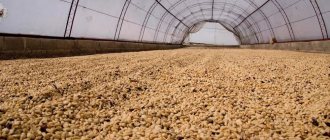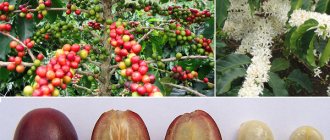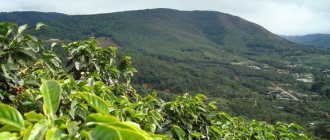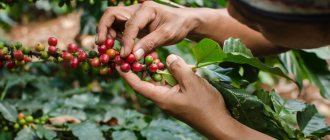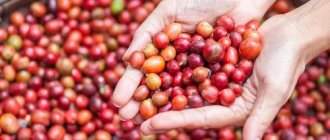For many of our fellow citizens, a good start to the day is a morning cup of coffee, which can set the mood and set you in a working mood, especially since it is much more pleasant to start the day with it.
When buying another package of coffee produced in France, Italy or Russia, you don’t even think about where the coffee beans are grown.
More than seventy countries supply a wide variety of coffee varieties to the world market. If you use the climatic principle, it becomes easier to navigate the countries where this wonderful fruit grows.
In which countries does coffee grow?
South America
Almost every third bag of coffee in the world is harvested in Brazil, which is at least forty million bags a year. It is used for mixtures and blends. Among the varieties of Brazilian coffee, mainly Arabica and Robusta. The low price is considered to be its main advantage.
Brazil's constant rival is Colombia, but it does not reach its level; it supplies the market with up to thirteen million bags of Arabica, but the quality of the product is higher. This allows it to be among the leaders in the supply of high-quality coffee, providing 15% of the world's volume.
Compared to the leaders, Peru's contribution, consisting of three to four million bags of coffee, seems more than modest. And his fame is not so wide. But single varieties, such as Chanchamayo, have quite excellent taste.
Central America
Honduras supplies about five million bags of Arabica. There are single varieties that are especially valued. For example, Madeo. But blends and mixtures are made from the bulk.
The average for Mexico is almost four million bags. Almost all of this volume is consumed by the United States. Mixtures for coffee machines - its purpose.
More than three million bags of Arabica and Robusta are supplied to the market from Guatemala. The famous Guatemalan Antigua is known to gourmets all over the world.
Almost half of the world's coffee bean crop is grown and supplied from South and Central America.
Asia
Asian countries are making plans to “catch up and overtake” the leaders. Moreover, the global coffee industry has long recognized the quality of many varieties ripening in the region as corresponding to the highest level.
Vietnam claims the right to join the list of world leaders. In a harvest year, the volume of supplies of Arabica and Robusta reaches thirty million bags. The country specializes in mixtures, blends and blends.
About ten million bags are supplied from Indonesia every year. This is mainly robusta; old varieties of arabica are also grown in very small quantities. Java coffee is especially popular; the Thoraya Sulawesi and Sumatra Mandeling varieties are classified as elite coffee, and Kopi Luwak is among the most expensive.
Arabica and Robusta varieties are supplied from India in a volume of more than five million bags. The coffee is a bit similar to Indonesian Robusta. It is added to mixtures. There are very special varieties, such as Malabar Monsoon, which have an unforgettable taste, and are harvested using a unique technique of aging grains on the ocean shore under the blow of the monsoon. This technology appeared here and is now successfully used by many.
Read: History of coffee
Africa
It was on this continent that coffee originated. It is far from America, but one thing is constant - the grain grown here is of consistently high quality.
The homeland of Arabica is Ethiopia, where the best coffee on the planet matures, where coffee trees have been growing on their own for hundreds of years and no one cultivates them. Six to seven million bags are its supplies.
Uganda grows mainly robusta, up to four million bags annually. It is added to various mixtures. Even though the yields here are not very high, the quality of local Arabica is very decent and even competes with Javanese varieties.
Some twenty years ago, quite recently, Côte d'Ivoire competed with Brazil and Colombia. The political situation in the country has negatively affected the volume of coffee exports. Today it is more than two million bags.
If you really love coffee, then you might be interested in expanding your knowledge about this drink a little and get acquainted with the seven most interesting facts about this drink. Some of which you may not have known before.
1. We owe the appearance of coffee... to goats
Or rather, their shepherd. Legend has it that coffee was first discovered quite by accident by one of the shepherds in Ethiopia. One day he noticed that some of the goats from his herd became hyperactive at certain times. Then he began to carefully observe his flock... And at some point he determined that the increasing activity of the goats was due to the fact that they were eating some kind of brown beans. It turned out to be coffee. Then the shepherd decided to taste them himself... This is how the whole world learned the taste of coffee.
2. Why can’t coffee be grown in Russia?
On an industrial scale, coffee can only be grown in the so-called “Bean Belt”. This is one parallel between the Southern and Northern tropics and it is there that suitable conditions have been created for growing coffee trees. Note that all coffee exporting countries are located precisely in this parallel! Russia is not one of them.
3. Coffee can be used to make... tea
Yes, yes, coffee leaves can be brewed. This results in a drink with a very unusual taste. It will be comparable in strength to tea, but will not have the “bitterness” characteristic of the latter. At the same time, coffee leaves contain fewer antioxidants, and a drink based on them helps reduce the risk of cardiovascular diseases and diabetes. This is facilitated by special compounds contained in coffee leaves.
4. We owe the appearance of the webcam to coffee
The first webcam in human history was created in order to use it to monitor whether there was enough drink in the coffee maker. This story took place in 1991 in Cambridge. The coffee maker was installed in Trojan Hall, and the employees who used it sat at the other end of the corridor. To always know whether one of their colleagues drank all the coffee, scientists invented... a web camera that broadcast the image to their computers. True, now it no longer works - it was turned off back in 2001.
5. The most popular type of coffee in the world is Arabica.
Almost 70% of the world's coffee is made from Arabica beans. However, instant coffee manufacturers often mix Arabica and Robusta. The second belongs to a lower grade, but is resistant to droughts and various diseases. And some coffee lovers prefer robusta for its bitter taste and half the amount of caffeine in one cup.
6. Americano appeared at the request of American soldiers
Americano coffee, beloved by many, appeared during the Second World War. The world owes its appearance to American military personnel. They were not used to the same strong coffee that Europeans loved and always asked the waiters to dilute the drink with water. Then the recipe for this drink arose, which today has millions of admirers in all corners of the globe.
7. Coffee is the most popular drink in the world
And the leaders in its consumption are residents of the northern countries - Finland and Sweden. They drink 200 liters of this drink per capita per year. The Germans drink a little less - 180 liters per person per year. In Norway this figure is about 150 liters. It is not surprising that coffee has taken root in Russia, where there are more cold days a year than warm ones. In total, 500 billion cups of coffee are drunk in the world every year.
Is coffee growing in Russia?
As mentioned above, coffee beans grow only in humid and hot climates. The ideal location for a coffee plantation is approximately 25° north and 30° south of the equator.
In our country, coffee beans are not grown on an industrial scale. But amateur gardeners can grow a coffee tree on their windowsill
Basic conditions for growing
- Availability of good lighting.
- Room temperature ≥18°C.
- Acidified soil.
- Do not frequently turn the plant towards the light.
- In summer, the plant can be taken outside.
- Wintering on a southern windowsill.
- Frequent spraying and regular watering with soft water.
Features of agricultural technology for coffee trees in a greenhouse
Since in nature coffee trees grow in regions with a humid, warm climate without sharp seasonal temperature changes, such conditions must be created in a greenhouse.
Attention! Coffee loves intense but diffused light, so it should not be exposed to the sun.
To grow coffee you need special greenhouses
For the normal development of a coffee tree in winter, the room temperature must be maintained within 15-17°C, while in the summer the thermometer in the greenhouse should not rise above 25°C.
Attention! The root system of the tree is especially affected by the cold, so the tub in which the coffee grows should not be placed on the ground. To prevent the roots of the tree from freezing, you need to place a high wooden pallet or thick cork flooring under the pot with the plant.
Coffee trees prefer loose, light soil and grow well only in slightly acidic soil. The optimal composition of the substrate for growing coffee:
- leaf soil - 3 parts;
- high-moor peat – 1 part;
- manure soil - 2 parts;
- washed river sand – 1 part.
Most often, coffee bushes are grown in pots.
Advice. To maintain the necessary acidity of the soil, once a month the substrate can be watered with a weakly concentrated solution of citric acid (literally a few crystals per liter of water).
Once every two years, in early spring, the coffee tree is transplanted into a new pot (slightly larger than the previous one).
Water the coffee without excess, but quite often, making sure that the top layer of the substrate in the pot does not dry out. Water for irrigation is used that is well settled and heated to 26-27°C. During the period of mass budding, watering is increased, and in the cold season - reduced. In addition, high air humidity is constantly maintained in the greenhouse, and the tree itself is often sprayed with a spray bottle.
Coffee bushes require high air humidity, as well as regular spraying.
Attention! During flowering, the tree cannot be sprayed, as droplets of water spoil the delicate petals and they quickly fall off. In order to achieve special lushness of foliage, during the periods between flowering, the coffee tree can be given an occasional warm shower.
Once a month (except in winter), the coffee tree is fed with a solution of complex fertilizers intended for roses.
Russian coffee
Russia is a gigantic and very diverse country, so there is no need to talk about coffee traditions that are common to all. Some coffee shops roast and grind the beans themselves, others buy a ready-made product, some offer the most basic set of coffee cocktails, somewhere you can even find such unusual variations as flat white - everything is different everywhere.
Raf coffee appeared in Russia
Russia also made its contribution to the development of world coffee culture - this is where Raf coffee appeared. This coffee cocktail was invented in the late 1990s and is a coffee-creamy mixture whipped with a cappuccino maker into a thick, uniform foam. Cappuccino and other variations also have milk or cream foam, but usually it is placed on top of the espresso, and only in Rafa the coffee and cream are whipped together at the same time.
The only common feature is that, unlike Western countries and the United States, takeaway coffee is not very popular in Russia. Russians prefer to drink an invigorating drink at home or in a coffee shop, snack on dessert and use this time to meet with friends or just relax. That’s why it’s not customary here to quickly drink your espresso at the coffee bar counter, as in Italy, and coffee shops usually offer an extensive menu, often including even hot dishes.
Since the early 2000s, “anti-cafes”—places where you have to pay for the time spent inside, rather than for drinks and food—have become especially popular among young people. Usually the price includes unlimited Internet use, coffee, tea, light snacks, and board games.
Coffee tree propagation
The germination of coffee seeds does not last long. It is useless to sprout store-bought beans, even if they are not roasted. Planting material can be purchased from owners of indoor coffee trees or during trips to tropical countries on plantations. Immediately place the grains in moist soil and take them home in a jar, preventing them from freezing. Shoots will appear in a month, but you will have to wait at least 5 years for the first harvest at home.
It is very difficult for grains to germinate. The hard shell does not allow the sprout to break through, and even if you sow many seeds just removed from the coffee tree, no shoots may appear. Help the embryo break through the skin: carefully cut off a small section of the skin. You can try another option; purchase a special product that dissolves the durable cover.
Advice
If you have the opportunity to choose from several types of planting material, choose Arabica. This variety tolerates unusual growing conditions at home more easily than others, develops quickly and does not require complex care.
There is an easier way to propagate a coffee bush: cut a cutting from another plant. The tree should be fruit-bearing, and choose branches in the middle of the crown. During the first years, the coffee tree at home grows very slowly, and then it will begin to intensively produce new shoots. In this case, you can get the first harvest in the third year.
Coffee propagation
In Russia, coffee is grown in greenhouses quite rarely, and the main reason for this is the difficulty of obtaining planting material. The coffee tree can be propagated by seeds and cuttings. Reproduction of coffee seeds is quite problematic, due to the fact that they are almost impossible to purchase. Propagation by cuttings can be complicated by the fact that they do not take root well.
Coffee is propagated by seeds and cuttings
Green (and even more so, roasted) coffee beans sold in stores will never sprout. Only seeds extracted from recently picked ripe coffee berries can germinate.
- The grains, freed from the juicy shell, are immersed in a light pink solution of potassium permanganate for several minutes, after which they are washed and cleaned of any remaining berry pulp.
- A small plastic container intended for growing seedlings is filled with a loose nutrient substrate prepared from equal parts of peat, disinfected turf soil and calcined river sand.
- Peeled coffee beans are laid flat side down on the surface of the substrate, lightly pressed into the soil with a fingertip, poured over with an almost colorless solution of potassium permanganate and covered with glass.
- The container with the crops is placed in a warm, shaded place. Every day, the substrate in the tray is ventilated and the dew is wiped off the glass, and watering is done as the soil dries.
Coffee bushes need monthly fertilizing - When sprouts emerge from the grains (this usually happens 35-45 days from the day of planting), they begin to increase the ventilation time, and then completely remove the glass from the seedlings.
- In the phase of the appearance of the third pair of leaves, young plants are planted in personal pots and, after rooting, they are exposed to the light.
- Coffee seedlings grown from seeds require virtually no shaping. The trees themselves grow evenly and beautifully, so the only thing that gardeners sometimes have to do is cut off the tips of excessively long side shoots.
During flowering, you cannot spray coffee, as the flowers may fall off.
Caring for coffee in a greenhouse is not particularly difficult, so even a novice gardener can grow a beautiful evergreen tree.
Caring for an exotic plant
A sharp change in temperature is contraindicated for the plant. The irrigation liquid should be several degrees warmer than the ambient temperature. If you pour water from the tap, pass it through a filter or boil it to remove salts. In summer, the plant needs a lot of moisture, make sure that the soil does not dry out. In winter, the bush rests; it does not need frequent watering; moisten it no more than once a week. During the warm season, be sure to spray the coffee tree daily.
Advice
Over time, the soil in the pot will become neutral or alkaline. To lower the pH, add a few grains of citric acid to the water every time you water.
To fertilize at home, use liquid rose fertilizer. During the period of activity it is necessary to feed every month and a half. When buds set and flowering occurs, choose products with a high content of nitrogen and phosphorus. During the dormant period, the tree does not need fertilizers.
You need to replant the flower at home once every 2 years. Please note that not only the above-ground part increases, but also the root system, so each time take a larger pot. The plant loves the light to always fall on it from one side. It is not advisable to rotate the pot; it is better to have an uneven crown and a good harvest than an even coffee tree without fruits.
If you want to brew coffee at home, evaluate the size of the room. This plant does not tolerate pruning well; it is better to let it develop naturally. In a cramped room, it may turn out that only a bush will live there, and there will be no room left for people. Of course, dry, diseased and damaged shoots must be removed immediately.
What is the bush complaining about?
As living conditions worsen, the appearance of the plant changes. If the leaves begin to lose color and shine, the bush lacks acid, water it with acidified water. In stagnant air, the crown begins to turn yellow and dry out. If the leaves rot, the air in the room is too humid.
The biggest danger for a coffee tree is hypothermia. If a black border begins to appear along the edges of the leaves, urgently move the pot to a warm place. When the cold comes from the bottom, place the container on a piece of wood or other heat-insulating material. The bush may survive, but if the leaves continue to turn black, the plant will soon die.
Periodically inspect the bush for pests:
- mealybug;
- aphids;
- scale insects;
- ticks.
If you notice parasites, treat the plant with insecticides. It is better to tear off severely damaged leaves, and wipe those with almost invisible wounds with a damp cloth.

